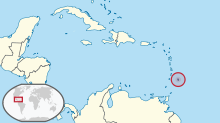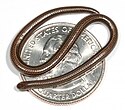Tetracheilostoma carlae
 Tetracheilostoma carlae na čtvrt dolaru, minci o průměru 24,26 mm. | |
| Stupeň ohrožení podle IUCN | |
 kriticky ohrožený druh[1] | |
| Vědecká klasifikace | |
| Říše | živočichové (Animalia) |
| Kmen | strunatci (Chordata) |
| Podkmen | obratlovci (Vertebrata) |
| Třída | plazi (Reptilia) |
| Řád | šupinatí (Squamata) |
| Podřád | hadi (Serpentes) |
| Infrařád | Scolecophidia |
| Čeleď | slepanovití (Leptotyphlopidae) |
| Binomické jméno | |
| Tetracheilostoma carlae Hedges; 2008 | |
| Některá data mohou pocházet z datové položky. | |
Tetracheilostoma carlae, též známý jako Leptotyphlops carlae, případně pro absenci českého pojmenování pod anglickým jménem jako Barbados threadsnake, je nejmenší had na světě. Patří do čeledi slepanovitých.[2]
Objev
Tento had byl jako samostatný druh poprvé popsán v roce 2008 herpetelogem S. B. Hedgesem z Pensylvánské univerzity. Hedges nový druh pojmenoval podle své ženy Carly Ann Hassové, která byla součástí herpatologického výzkumného týmu. Záznamy o tomto hadu existovaly ve sbírkách londýnského Natural History Museum a v kalifornském muzeu, ale byly neprávně identifikovány jako jiný již známý druh. Předpokládá se, že dospělý jedinec Tetracheilostoma carlae se velmi blíží hranici minimální velikosti hada, protože hadí mláďata musí mít při vylíhnutí určitou velikost, aby sehnala potravu; menší had podle vědců ani nemůže existovat. [2][3]
Vzhled
Jedná se o nejmenší druh hada na světě. Průměrná délka dospělých jedinců Tetracheilostoma carlae je přibližně 10 cm (3,94 palce); největší dosud nalezený jedinec měřil 10,4 cm (4,09 palce). Podle obyvatel ostrova Barbados jsou tito malí hadi širocí jako špageta. Nově vylíhlá mláďata mají asi poloviční délku oproti dospělým.[3][4]
Předpokládá se, že se Tetracheilostoma carlae živí především termity a mravenci.[5]
Samice snáší najednou pouze jedno velké vejce.[5]
Výskyt
Tetracheilostoma carlae obývá hlavně karibský ostrov Barbados. Zaznamenán byl i na karibských tropických ostrovech Antigua a Barbuda, ale není jisté, zda šlo opravdu o tento druh, nebo pouze o druh příbuzný, takže se zatím předpokládá, že Tetracheilostoma carlae je endemický živočich.[2][4]
Ochrana
O ekologii tohoto druhu, stejně jako o počtu jedinců a rozšíření, je známo jen málo. Na ostrově Barbados nezbývá téměř žádné původní zalesnění, tento druh je na jeho zbytcích pravděpodobně závislý, protože, jak svědčí archeologické nálezy, se v lesním prostředí vyvinul. Zdá se, že had je rozšířen jen na východní části ostrova a budoucnost druhu je, i proto, že vědcům chybí informace o životě druhu Tetracheilostoma carlae, na kterých by mohli vystavět funkční plán na ochranu, velmi nejistá a had je zařazen na červeném seznamu ohrožených druhů IUNC jako kriticky ohrožený.[6][2]
Reference
V tomto článku byl použit překlad textu z článku Barbados threadsnake na anglické Wikipedii.
- ↑ Červený seznam IUCN ohrožených druhů 2021.3. 9. prosince 2021. Dostupné online. [cit. 2021-12-23]
- ↑ a b c d HEDGES, S. Blair. At the lower size limit in snakes: two new species of threadsnakes (Squamata: Leptotyphlopidae: Leptotyphlops) from the Lesser Antilles. S. 1. Zootaxa [online]. 2008-08-04 [cit. 2020-05-22]. Roč. 1841, čís. 1, s. 1. Dostupné online. DOI 10.11646/zootaxa.1841.1.1. (anglicky)
- ↑ a b THE REPTILE DATABASE. www.reptile-database.org [online]. [cit. 2020-05-22]. Dostupné online.
- ↑ a b BRAHIC, Catherine. World's smallest snake discovered. New Scientist [online]. 2008-08-03 [cit. 2020-05-22]. Dostupné online. (anglicky)
- ↑ a b World's smallest snake is as thin as spaghetti | Reuters. web.archive.org [online]. 2008-09-02 [cit. 2020-05-22]. Dostupné v archivu pořízeném z originálu dne 2008-09-02.
- ↑ Barbados Threadsnake [online]. IUCN Red List of Threatened Species, 2015-07-22 [cit. 2020-05-22]. Dostupné online. (anglicky)
Externí odkazy
 Obrázky, zvuky či videa k tématu Tetracheilostoma carlae na Wikimedia Commons
Obrázky, zvuky či videa k tématu Tetracheilostoma carlae na Wikimedia Commons  Taxon Tetracheilostoma carlae ve Wikidruzích
Taxon Tetracheilostoma carlae ve Wikidruzích
Média použitá na této stránce
Autor:
- Information-silk.png: Mark James
- derivative work: KSiOM(Talk)
A tiny blue 'i' information icon converted from the Silk icon set at famfamfam.com
- The smallest animals have young that are proportionately enormous relative to the adults. The figure shows that hatchlings of the smallest snakes are one-half the length of an adult, whereas the hatchlings of the largest snakes are only one-tenth the length of an adult. Tiny snakes produce only one massive egg -- relative to the size of the mother -- which suggests that natural selection is trying to keep the size of hatchlings above a critical limit in order for them to survive.
Autor: TUBS
Location of XY (see filename) in the region.
Autor: Nicolas Perrault III, Licence: CC0
This is an individual of the smallest snake species in the world, the Barbados threadsnake (Tetracheilostoma carlae, or, prior to 2009, Leptotyphlops carlae). It was found, along with two other individuals, in the backyard of St-Nicholas Abbey, in Barbados.
Identification of Tetracheilostoma carlae is difficult, especially since a recently introduced invasive species was introduced on the island of Barbados, is very similar looking to T. carlae, and seems to be much more common. The above specimen was identified (with the aid of supplemental pictures) by the biologist who initially described the species (Blair Hedges, through personal communication).
Here are the snake's specifications:
- Total length: 99 mm
- Head width: 4.5 mm
- Midbody width: 4.0 mm
The snake was caught in the backyard of St-Nicholas Abbey, St-Peter's, Barbados at 12:50 EDT on 16 May 2013 and released at 15:00 EDT on 20 May 2013 at the exact location of capture. We could not feed the snake during the holding times because it has a narrow diet (ant larvae and termites). It looked just fine at the time of release. The snake escaped its box into the laboratory somewhere between 15:00 and 20:00 EDT, 16 May 2013. It was found in the same laboratory between 14:00 and 17:00 EDT, 17 May 2013.
On 19 May 2013, we found two extra snakes at the same location. I thank Larry Warren, owner of the St-Nicholas Abbey (a heritage house and rum distillery), for letting us freely sample on the house's property, and Dr. Blair Hedges of Pennsylvania State University for identifying the snake.
The coordinates below point to the location at which I found the snake, not that of the laboratory in which I took the picture.







